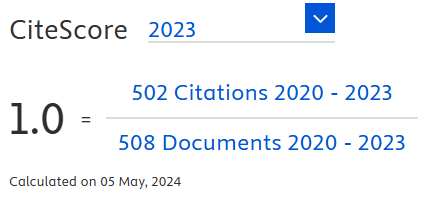In-vitro antibacterial activity, Molecular docking, and MD Simulation Analysis of Phytoconstituents of Nasturtium officinale
DOI:
https://doi.org/10.18006/2024.12(6).838.849Keywords:
Nasturtium officinale, Staphylococcus aureus, Antibacterial activity, TLC fingerprint, Molecular docking, MD SimulationAbstract
Medicinal plants play a significant role in various traditional medicine systems worldwide. Nasturtium officinale W.T. Aiton, commonly known as ‘Halim,’ is a herbaceous perennial often used for its multiple health benefits. It serves as a depurative, diuretic, expectorant, hypoglycemic, hypolipidemic, and odontalgic agent and is utilized in the management of various ailments and disorders. This study aimed to evaluate the antimicrobial efficacy of different solvent extracts of N. officinale against Staphylococcus aureus. The antimicrobial activity was assessed through an in vitro assay using the disk diffusion method. Additionally, the minimum inhibitory concentration (MIC) was determined in comparison with standard reference compounds. Among the extracts tested, the chloroform extract of N. officinale (NOCE) exhibited the most potent inhibitory effect, demonstrating significant antibacterial activity. The high efficacy of the NOCE suggests that it may contain active phytoconstituents capable of targeting bacterial strains. Furthermore, molecular docking studies revealed that the phytoconstituents isorhamnetin, luteolin, and quercetin exhibited strong interactions with bacterial DNA gyrase. The molecular dynamics (MD) simulation of the best-docked compound, isorhamnetin, against bacterial DNA gyrase indicated that all parameters were within acceptable limits, and the compound effectively interacted with the receptor. These findings confirm that N. officinale possesses potential antibacterial activity, which may be attributed to the presence of isorhamnetin.
References
Akbari Bazm, M., Khazaei, M., Khazaei, F., & Naseri, L. (2019). Nasturtium Officinale L. hydroalcoholic extract improved oxymetholone-induced oxidative injury in mouse testis and sperm parameters. Andrologia, 51(7), e13294. DOI: https://doi.org/10.1111/and.13294
Ayele, T. T., Regasa, M. B., & Delesa, D. A. (2015). Antibacterial and antagonistic activity of selected traditional medicinal plants and herbs from East Wollega Zone against clinical isolated human pathogens. Science, Technology and Arts Research Journal, 4(3), 175-179. DOI: https://doi.org/10.4314/star.v4i3.26
Barnes, V.L., Heithoff, D.M., Mahan, S.P., House, J.K., & Mahan, M.J. (2023). Antimicrobial susceptibility testing to evaluate minimum inhibitory concentration values of clinically relevant antibiotics. STAR Protocols, 4(3), 102512. DOI: https://doi.org/10.1016/j.xpro.2023.102512
Biemer, J.J. (1971). Antimicrobial susceptibility testing by the Kirby-Bauer disc diffusion method. Annals of Clinical & Laboratory Science, 3(2), 135-40.
Bisht, A., Tewari, D., Kumar, S., & Chandra, S. (2024). Network pharmacology, molecular docking, and molecular dynamics simulation to elucidate the mechanism of anti-aging action of Tinospora cordifolia. Molecular Diversity, 28(3), 1743-1763. DOI: https://doi.org/10.1007/s11030-023-10684-w
Butnariu, M., & Bostan, C. (2011). Antimicrobial and anti-inflammatory activities of the volatile oil compounds from Tropaeolum majus L.(Nasturtium). African journal of biotechnology, 10(31), 5900-5909. DOI: https://doi.org/10.5897/AJB11.264
Dos Santos Nascimento, I.J., & de Moura, R.O. (2024). Molecular Dynamics Simulations in Drug Discovery. Mini Reviews in Medicinal Chemistry, 24(11), 1061-1062. DOI: https://doi.org/10.2174/138955752411240402134719
Dubale, S., Kebebe, D., Zeynudin, A., Abdissa, N., & Suleman, S. (2023). Phytochemical screening and antimicrobial activity evaluation of selected medicinal plants in Ethiopia. Journal of experimental pharmacology, 15, 51-62. DOI: https://doi.org/10.2147/JEP.S379805
Ercan, L., & Doğru, M. (2023). Determination of phenolic compounds in Nasturtium Officinale by LC-MS/MS using different extraction methods and different solvents. International Journal of Chemistry and Technology, 7(2), 124-130. DOI: https://doi.org/10.32571/ijct.1150482
Farhadi, F., Khameneh, B., Iranshahi, M., & Iranshahy, M. (2019). Antibacterial activity of flavonoids and their structure–activity relationship: An update review. Phytotherapy Research, 33(1), 13-40. DOI: https://doi.org/10.1002/ptr.6208
Farnsworth, N. R. (1966). Biological and phytochemical screening of plants. Journal of Pharmaceutical Sciences, 55(3), 225-276. DOI: https://doi.org/10.1002/jps.2600550302
Goodsell D.S., Sanner M.F., Olson A.J., & Forli S. (2021). The AutoDock suite at 30. Protein Science, 30(1) 31-43. DOI: https://doi.org/10.1002/pro.3934
Hanwell M.D., Curtis D.E., Lonie, D.C., Vandermeersch T., Zurek E., & Hutchison G.R. (2012). Avogadro: an advanced semantic chemical editor, visualization, and analysis platform. Journal of Cheminformatics, 4, 17. DOI: https://doi.org/10.1186/1758-2946-4-17
Hemeg, H.A., Moussa, I.M., Ibrahim, S., Dawoud, T.M., Alhaji, J.H., et al. (2020). Antimicrobial effect of different herbal plant extracts against different microbial population. Saudi Journal of Biological Sciences, 27(12), 3221-3227. DOI: https://doi.org/10.1016/j.sjbs.2020.08.015
Hibbert, L.E., Qian, Y., Smith, H.K., Milner, S., Katz, E., Kliebenstein, D.J., & Taylor, G. (2023). Making watercress (Nasturtium officinale) cropping sustainable: genomic insights into enhanced phosphorus use efficiency in an aquatic crop. Frontiers in Plant Science, 14, 1279823. DOI: https://doi.org/10.3389/fpls.2023.1279823
Huang, H., Zhang, Y., Du, Q., Zheng, C., Jin, C., & Li, S. (2024). Synthesis and Antimicrobial Activity of 3-Alkylidene-2-Indolone Derivatives. Molecules, 29(22), 5384. DOI: https://doi.org/10.3390/molecules29225384
Ilieva, Y., Zaharieva, M.M., Najdenski, H., & Kroumov, A.D. (2024). Antimicrobial Activity of Arthrospira (Former Spirulina) and Dunaliella Related to Recognized Antimicrobial Bioactive Compounds. International Journal of Molecular Sciences, 25(10), 5548. DOI: https://doi.org/10.3390/ijms25105548
Jalali, P., Nowroozi, A., Moradi, S., & Shahlaei, M. (2024). Exploration of lipid bilayer mechanical properties using molecular dynamics simulation. Archives of Biochemistry and Biophysics, 761, 110151. DOI: https://doi.org/10.1016/j.abb.2024.110151
Jang, M., Hong, E., & Kim, G. H. (2010). Evaluation of antibacterial activity of 3‐butenyl, 4‐pentenyl, 2‐phenylethyl, and benzyl isothiocyanate in Brassica vegetables. Journal of food science, 75(7), M412-M416. DOI: https://doi.org/10.1111/j.1750-3841.2010.01725.x
Jiang, L., Li, H., Wang, L., Song, Z., Shi, L., Li, W., Deng, X., & Wang, J. (2016). Isorhamnetin Attenuates Staphylococcus aureus Induced Lung Cell Injury by Inhibiting Alpha-Hemolysin Expression. Journal of Microbiology and Biotechnology, 26(3), 596-602. DOI: https://doi.org/10.4014/jmb.1507.07091
Jones, W.P., & Kinghorn, A.D. (2012). Extraction of plant secondary metabolites. Methods in Molecular Biology, 864, 341-66. DOI: https://doi.org/10.1007/978-1-61779-624-1_13
Joshi, B.C., Juyal, V., & Sah, A.N. (2024). First Report on Pharmacognostic, Phytochemical Investigation and In vitro Radical Scavenging Efficacy of Premna barbata from Western Himalaya. Proceedings of the National Academy of Sciences, India Section B: Biological Sciences, 94, 685–695. DOI: https://doi.org/10.1007/s40011-024-01552-0
Kar, P., Oriola, A.O., & Oyedeji, A.O. (2024). Molecular Docking Approach for Biological Interaction of Green Synthesized Nanoparticles. Molecules, 29(11), 2428. DOI: https://doi.org/10.3390/molecules29112428
Kawsar, S.M.A., Hossain, M.A., Saha, S., Abdallah, E.M., Bhat, A.R., Ahmed, S., Jamalis, J., & Ozeki Y. (2024). Nucleoside-Based Drug Target with General Antimicrobial Screening and Specific Computational Studies against SARS-CoV-2 Main Protease. Chemistry Select, 9, e202304774. DOI: https://doi.org/10.1002/slct.202304774
Khan, M.I., Pathania, S., Al-Rabia, M.W., Ethayathulla, A.S., Khan, M.I., et al. (2024). MolDy: molecular dynamics simulation made easy. Bioinformatics, 40(6), btae313. DOI: https://doi.org/10.1093/bioinformatics/btae313
Kim S., Lee J., Jo S., Brooks C.L. 3rd., Lee H.S., & Im W. (2017). CHARMM-GUI ligand reader and modeler for CHARMM force field generation of small molecules. Journal of Computational Chemistry , 38(21) 1879-1886. DOI: https://doi.org/10.1002/jcc.24829
Klimek-Szczykutowicz, M., Szopa, A., & Ekiert, H. (2018). Chemical composition, traditional and professional use in medicine, application in environmental protection, position in food and cosmetics industries, and biotechnological studies of Nasturtium officinale (watercress) - a review. Fitoterapia, 129, 283-292. DOI: https://doi.org/10.1016/j.fitote.2018.05.031
Kulathunga, D.G., & Rubin, J.E. (2017). A review of the current state of antimicrobial susceptibility test methods for Brachyspira. Canadian Journal of Microbiology, 63(6), 465-474. DOI: https://doi.org/10.1139/cjm-2016-0756
Kumari, R., & Kumar, R. (2014). Open Source Drug Discovery Consortium, Lynn A. g_mmpbsa-A GROMACS Tool for High-Throughput MM-PBSA Calculations. Journal of Chemical Information and Modeling, 54(7), 1951–1962. DOI: https://doi.org/10.1021/ci500020m
Kushwaha, P.P., Singh, A.K., Bansal, T., Yadav, A., Prajapati, K.S., Mohd, S., & Kumar, S. (2021). Identification of Natural Inhibitors Against SARSCoV-2 Drugable Targets Using Molecular Docking, Molecular Dynamics Simulation, and MM-PBSA Approach. Frontier Cellular Infection Microbiology, 11, 730288. DOI: https://doi.org/10.3389/fcimb.2021.730288
Lemkul, J.A. (2018). From Proteins to Perturbed Hamiltonians: A Suite of Tutorials for the GROMACS-2018 Molecular Simulation Package, v1.0”. Living Journal of Computational Molecular Science, 1(1), 5068. DOI: https://doi.org/10.33011/livecoms.1.1.5068
Lokhande, K., Nawani, N.K., Venkateswara, S., & Pawar, S. (2022). Biflavonoids from Rhus succedanea as probable natural inhibitors against SARS-CoV-2: a molecular docking and molecular dynamics approach. Journal of Biomolecular Structure Dynamics, 40(10), 4376-4388. DOI: https://doi.org/10.1080/07391102.2020.1858165
Mabhiza, D., Chitemerere, T., & Mukanganyama, S. (2016). Antibacterial properties of alkaloid extracts from Callistemon citrinus and Vernonia adoensis against Staphylococcus aureus and Pseudomonas aeruginosa. International Journal of Medicinal Chemistry, 2016(1), 6304163. DOI: https://doi.org/10.1155/2016/6304163
Mahdavi, S., Kheyrollahi, M., Sheikhloei, H., & Isazadeh, A. (2019). Antibacterial and antioxidant activities of essential oil on food borne bacteria. The Open Microbiology Journal, 13(1), 81-85. DOI: https://doi.org/10.2174/1874285801913010081
Mayasari, D., Murti, Y.B., Pratiwi, S.U.T., Sudarsono, S., Hanna, G., & Hamann, M.T. (2022). TLC-Based Fingerprinting Analysis of the Geographical Variation of Melastoma malabathricum in Inland and Archipelago Regions: A Rapid and Easy-to-Use Tool for Field Metabolomics Studies. Journal of Natural Products, 85(1), 292-300. DOI: https://doi.org/10.1021/acs.jnatprod.1c00622
Mostafazadeh, M., Sadeghi, H., Sadeghi, H., Zarezade, V., Hadinia, A., & Panahi Kokhdan, E. (2022). Further evidence to support acute and chronic anti-inflammatory effects of Nasturtium officinale. Research in Pharmaceutical Sciences, 17(3), 305-314. DOI: https://doi.org/10.4103/1735-5362.343084
Nair, J.J., Wilhelm, A., Bonnet, S.L., & van Staden, J. (2017). Antibacterial constituents of the plant family Amaryllidaceae. Bioorganic & Medicinal Chemistry Letters, 27(22), 4943-4951. DOI: https://doi.org/10.1016/j.bmcl.2017.09.052
Negi, N., Upadhyay, S., & Rana, M. (2024a). An Overview on Phytopharmacological Perspectives of a Potential plant Species: Nasturtium officinale. Systematic Reviews in Pharmacy, 15(8), 257-262.
Negi, N., Upadhyay, S., & Rana, M. (2024b). Investigation of in vitro anticancer potential and phytochemical screening of Nasturtium officinale. International Journal of Zoological Investigations, 10(1), 537-544. DOI: https://doi.org/10.33745/ijzi.2024.v10i01.058
Nocedo-Mena, D., Garza-González, E., González-Ferrara, M., & Del Rayo Camacho-Corona, M. (2020). Antibacterial Activity of Cissus incisa Extracts against Multidrug- Resistant Bacteria. Current Topics in Medicinal Chemistry, 20(4), 318-323. DOI: https://doi.org/10.2174/1568026619666191121123926
Notarte, K.I.R., Quimque, M.T.J., Macaranas, I.T., Khan, A., Pastrana, A.M., et al. (2023). Attenuation of Lipopolysaccharide-induced Inflammatory Responses through Inhibition of the NF-κB Pathway and the Increased NRF2 Level by a Flavonol-enriched n-Butanol Fraction from Uvaria alba. ACS Omega, 8(6), 5377–5392. DOI: https://doi.org/10.1021/acsomega.2c06451
Paggi, J.M., Pandit, A., & Dror, R.O. (2024). The Art and Science of Molecular Docking. Annual Review of Biochemistry, 93(1), 389-410. DOI: https://doi.org/10.1146/annurev-biochem-030222-120000
Prinsa., Saha, S., Bulbul, M.Z.H., Ozeki, Y., Alamri, M.A., & Kawsar, S.M.A. (2024). Flavonoids as potential KRAS inhibitors: DFT, molecular docking, molecular dynamics simulation and ADMET analyses. Journal of Asian Natural Product Research, 26(8), 955-992. DOI: https://doi.org/10.1080/10286020.2024.2343821
Priscilla, K., Sharma, V., Gautam, A., Gupta, P., Dagar, R., Kishore, V., & Kumar, R. (2024). Carotenoid Extraction from Plant Tissues. Methods in Molecular Biology, 2788, 3-18. DOI: https://doi.org/10.1007/978-1-0716-3782-1_1
Rigby, S.P. (2024). Uses of Molecular Docking Simulations in Elucidating Synergistic, Additive, and/or Multi-Target (SAM) Effects of Herbal Medicines. Molecules, 29(22), 5406. DOI: https://doi.org/10.3390/molecules29225406
Shakerinasab, N., Mottaghipisheh, J., Eftekhari, M., Sadeghi, H., Bazarganipour, F., Abbasi, R., Doustimotlagh, A.H. & Iriti, M. (2024). The hydroalcoholic extract of Nasturtium officinale reduces oxidative stress markers and increases total antioxidant capacity in patients with asthma. Journal of Ethnopharmacology, 318, 116862. DOI: https://doi.org/10.1016/j.jep.2023.116862
Sherer, B.A., Hull, K., Green, O., Basarab, G., Hauck, S., et al. (2011). Pyrrolamide DNA gyrase inhibitors: Optimization of antibacterial activity and efficacy. Bioorganic & medicinal chemistry letters, 21(24), 7416-7420. DOI: https://doi.org/10.1016/j.bmcl.2011.10.010
Suarez, A.F.L., Tirador, A.D.G., Villorente, Z.M., Bagarinao, C.F., Sollesta, J.V.N., et al. (2021). The Isorhamnetin-Containing Fraction of Philippine Honey Produced by the Stingless Bee Tetragonula biroi Is an Antibiotic against Multidrug-Resistant Staphylococcus aureus. Molecules, 26(6), 1688. DOI: https://doi.org/10.3390/molecules26061688
Tabesh, M., Sh, M.E., Etemadi, M., Naddaf, F., Heidari, F., & Alizargar, J. (2022). The antibacterial activity of Nasturtium officinale extract on common oral pathogenic bacteria. Nigerian Journal of Clinical Practice, 25(9), 1466-1475. DOI: https://doi.org/10.4103/njcp.njcp_1887_21
Tittikpina, N.K., Nana, F., Fontanay, S., Philippot, S., Batawila, K., et al. (2018). Antibacterial activity and cytotoxicity of Pterocarpus erinaceus Poir extracts, fractions and isolated compounds. Journal of Ethnopharmacology, 212, 200-207. DOI: https://doi.org/10.1016/j.jep.2017.10.020
Yu, D., Li, H., Liu, Y., Yang, X., Yang, W., Fu, Y., Zuo, Y.A., & Huang, X. (2024). Application of the molecular dynamics simulation GROMACS in food science. Food Research International, 190, 114653. DOI: https://doi.org/10.1016/j.foodres.2024.114653
Zhao, S., Baik, O.D., Choi, Y.J., & Kim, S.M. (2014). Pretreatments for the efficient extraction of bioactive compounds from plant-based biomaterials. Critical Reviews in Food Science and Nutrition, 54(10), 1283-97. DOI: https://doi.org/10.1080/10408398.2011.632698
Zhong, H., Liu, H., & Liu, H. (2024). Molecular Mechanism of Tau Misfolding and Aggregation: Insights from Molecular Dynamics Simulation. Current Medicinal Chemistry, 31(20), 2855-2871. DOI: https://doi.org/10.2174/0929867330666230409145247
Downloads
Published
How to Cite
License
Copyright (c) 2025 Journal of Experimental Biology and Agricultural Sciences

This work is licensed under a Creative Commons Attribution-NonCommercial 4.0 International License.












